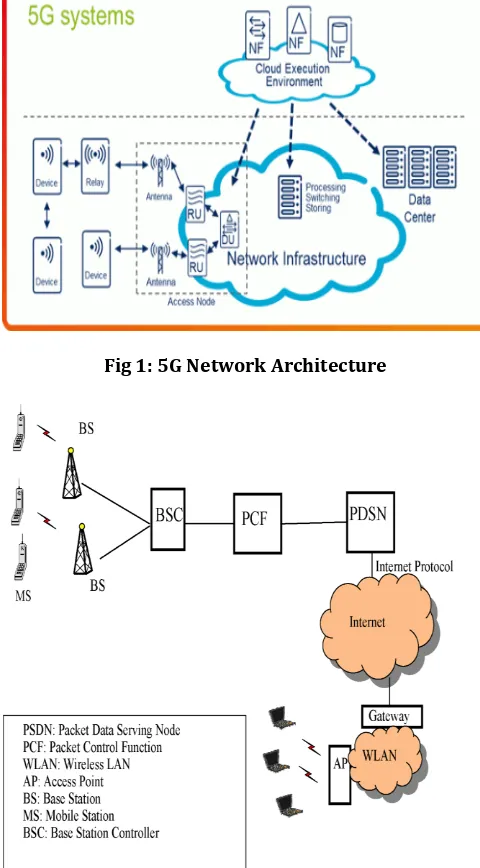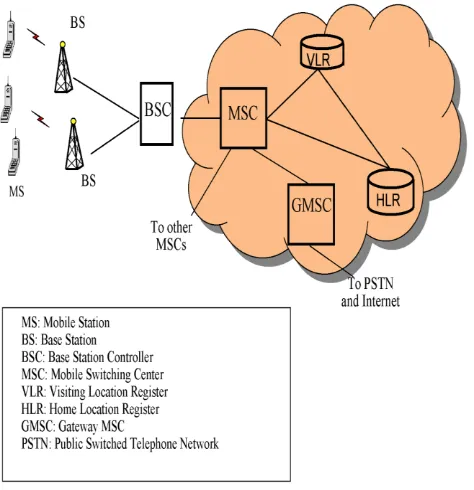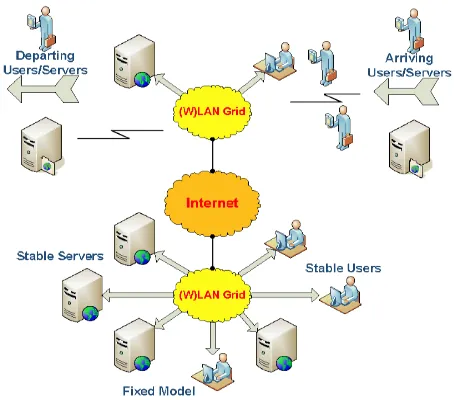© 2018, IRJET | Impact Factor value: 6.171 | ISO 9001:2008 Certified Journal | Page 395
5G MOBILE TECHNOLOGY
Arockia Panimalar.S
1, Iniya.R
1, Priyadharshini.P
2, Abirami.P
31
Assistant Professor, Department of BCA & M.Sc SS, Sri Krishna Arts and Science College, Tamilnadu
2,3,4III BCA A M.Sc SS, Department of BCA & M.Sc SS, Sri Krishna Arts and Science College, Tamilnadu
---***---Abstract:
In 5G technologies the user can access the most high-bandwidth using their phones. 5G pushed over a VOIP-enabled device, people experience a level of call volume and data transmission that they never experienced before. 5G technology offer services in product engineering, documentation, supporting electronic transactions (e-payments, e-transactions), etc. Today people have mobile phone with more advanced features and the mobile technology become more aware for customers, and the customers look for the advanced options. The paper develops around 5G (Fifth Generation), a mobile network concept which is viewed as user centric concept rather than operator-centric as in 3G or service-centric concept as observed for 4G. Now-a-days the mobile user is on the top of all. The 5G terminals have Software characterized radios and modulation scheme and also error-control schemes can be downloaded from the Internet on the run. The 5G mobile development is seen on the user terminals as a focus of the mobile networks.Key Words
:
2G, 3G, 4G and 5G Technologies
1. INTRODUCTION
Smart phones have numerous propelled highlights and it ranges from the littlest size, biggest phone memory, speed dialing, video player, sound player, and camera. Recently, with the development of Piconets and Bluetooth technology, data sharing has become a very fast. Earlier days with the infrared feature we can share data within a line of sight that means the two devices has to be aligned properly to transfer data, but in case of bluetooth we can transfer data even when you have the mobile phone in your pocket up to a range of 50 meters.
The entry of 5G mobile technology in marketing will launch a new revolution in mobile marketing. Regarding the 4G, its focus is towards integration of cellular networks such as GSM and 3G, WLAN and Bluetooth. The multimode user terminal must have for 4G, but different security
mechanisms in different wireless technologies remain a challenge.
2. FEATURES OF FOURTH GENERATION
There are several reasons which are sufficient to answer a simple question- why do we need to adopt 4G technology. The following are a portion of the highlights of 4G which make it a "most importantly" technology.
2.1 High Performance
The users will not be able to take advantages of rich multimedia content across wireless networks with 4G. Interestingly, 4G will highlight to a high-quality videos contrasted with HD (High Definition) TV. Wireless downloads should be possible at the speed of 100 Mbps, i.e. 50 times of 3G are conceivable with 4G.
2.2 Interoperability and Easy Roaming
4G will give various types of terminals, which may provide common services independently of their capabilities. The interoperability of the standards of 3G make it hard to roam on the different networks, the 4G network gives a worldwide standard and worldwide portability. WiMAX is likewise considered as a wireless backhaul innovation for 2G, 3G and 4G. Diverse wireless access networks normally change similar to scope, data rate, latency and loss rate. Each of them is for all intents and purposes intended to help an alternate arrangement of particular services and devices.
2.3 Fully Converged Services
PDAs is free to do so in 4G which delivers connectivity intelligent and flexible enough to support streaming video, VoIP telephony, still or moving images, e-mail, web browsing, e-commerce, and location-based services through a wide variety of devices. It means “Freedom for Consumers”. User can access the network from lots of different platforms like cell phones, laptops.
2.4 Low Cost
© 2018, IRJET | Impact Factor value: 6.171 | ISO 9001:2008 Certified Journal | Page 396
2.5 Devices: More User-friendly Interface
4G device will have the capacity to interact with environment around it and act as needs be. 4G devices are relied upon to be more visual and instinctive as opposed to the present content and menu-based systems.
2.6 Enhanced GPS Services
In addition to locating individuals, a 4G version of GPS technology might be able to let people be virtually present in a variety of places.
2.7 Scalability
The most challenging aspect of mobile network is to refer the ability to handle ever increasing number of users and services. IP core layer of 4G is effectively versatile, it is in a perfect world suited to address this difficulty.
2.8 Crisis-Management Applications
Natural disasters can affect the entire communications infrastructure in disarray. Restoring communications quickly is essential. The wireless mobile communications, video services and internet could be set up in hours rather than days or even weeks required for reclamation of wire line communications
.
3. CHALLENGES IN MIGRATION TO 4G
3.1 Multimode User Terminals
Using software radio, the problem in 3G can be solved i.e. user terminal adapts itself to the wireless interfaces of the network. The 4G network is needed to design a single user terminal that can operate in different wireless networks and overcome the design problems such as limitations in size of the device, its cost and power consumption.
3.2 Selection among Various Wireless Systems
The wireless technologies complicate the selection of most suitable technology for a particular service at a particular place and time. Every wireless network has its unique characteristics and roles. This process can be handled by selecting the available network resources and fit for user requirements.
3.3 Security
The wireless networks complicate the security issue. Reconfigurable, adaptive and lightweight security mechanisms will be developed.
3.4 Network Infrastructure and QoS Support
Providing the existing IP and non-IP based systems for end-to-end services becomes a very challenging one now-a-days.
3.5 Charging/ Billing
The customer access information is stored from multiple providers. Similarly, billing customers is easy and simple but information is not an easy task.
3.6 Attacks on Application Level
The 4G Mobile Network is well known for their software applications, which provides best feature to the users there by leading to more attacks at their application level.
3.7 Jamming and Spoofing
The fake GPS signals sending out are called Spoofing. The GPS receiver thinks that the signals have come from the satellite and they display the wrong co-ordinates. Criminals and hackers use this technique to interfere in the police works. Jamming happens when a transmitter sends many data at a time and at same frequency that displaces a GPS signal.
3.8 Data Encryption
During the data encryption, the central transmitter has to communicate with GPS receiver. The central transmitter is not hard to break and there is a need of encrypting the data.
4. EVOLUTION OF 5G MOBILE NETWORKS
The vertical handovers ought not to be utilized, in light of the fact that they are not plausible for some innovations and numerous operators and service providers. The 5G mobile access network grants a service and the 5G network is in-charge of dealing with the mobile users which is the last decision for various wireless networks. These choices will be based on open intelligent middleware in the mobile phone networks. The terminals will access the different wireless technologies. The 5G terminals will have software defined radios which will deliver high bandwidth and lower latency than ever before in mobile networks. The development is seen towards the user terminals as a focus of the 5G mobile networks.
4.1 Physical/MAC Layers
Physical and Medium Access Control layers i.e. OSI layer 1 and OSI layer 2, defines the wireless technology. For these two layers the 5G mobile networks is likely to be based on Open Wireless Architecture.
4.2 Network Layer
© 2018, IRJET | Impact Factor value: 6.171 | ISO 9001:2008 Certified Journal | Page 397 network address. There is mobile IP standard on one side
and micro-mobility solutions on the other side (e.g., Cellular IP, HAWAII and so forth). Each and every portable system use Mobile IP in 5G, and each mobile system will be FA (Foreign Agent), keeping the CoA (Care of Address) mapping between its IPv6 address.
4.3 Open Transport Protocol (OTA) Layer
The wireless networks will differ from networks regarding the transport layer. In most of the TCP versions, the loss of segments is due to network connections. Due to high bit error ratio in radio interface wireless network losses occurs. TCP modifications and adaptation are proposed for the mobile and wireless networks. The 5G mobile network has the reasonable transport layer that can be downloaded and installed. The 5G mobile network has the probability to download TCP or the new transport convention or protocol which is engaged to a specific wireless technology is presented at the base station. This is called Open Transport Protocol (OTP).
4.4 Application Layer
For improving the high data rates, the wireless networks provide communication to fulfill the goals of personal computing. In future, wireless networks give a low intricacy of usage and acts a productive methods for transaction between the end users and the wireless infrastructure. For the mobile IP based core networks, it will be more helpful. An intelligent QoS management has to provide 5g mobile networks to a variety of users. Today, in cell phones the users physically select the wireless interface for specific Internet service.The QoS history management service plays a vital role for wireless network connections. The 5G mobile network will provide storage of measurement information. The QoS parameters, for example, delay, jitter, losses, transfer speed, reliability will be put away in a database in the 5G mobile networks with an intend to be utilized by intelligent algorithms running in 5G mobile terminal as system processes which toward the end, the 5G mobile networks will give the best wireless connection upon required QoS and personal cost limitations. The scope of model service is available in 4G. These services and models should be additionally inspected for their interface with the plan of 4G systems.The process of IPv4 address exhaustion is expected to be in its final stages by the time that 4G is deployed. Therefore, IPv6 support for 4G is essential in order to support a large number of wireless enabled devices. IPv6 removes the need for NAT (Network Address Translation) by increasing the number of IP addresses.
5. NETWORK ARCHITECTURE
[image:3.595.311.551.98.532.2]In base stations the mobile phone is connected to a wired in single hop wireless networks, which is responsible for carrying a call in a particular region called cells. Due to limited coverage provided by base stations, the mobile hot spots change their connecting base stations as they move from cell to another cell.
Fig 1: 5G Network Architecture
Fig 2: Wireless Mobile System Network Architecture
© 2018, IRJET | Impact Factor value: 6.171 | ISO 9001:2008 Certified Journal | Page 398 Fig 3: Mobile System/WLAN Integration
[image:4.595.48.285.93.338.2]For frequency shift key signaling in first generation, the analogy systems is used from the range of 450-900MHz frequency and it is also used for Frequency Division Multiple Access(FDMA) and for spectrum sharing. The second-generation implementation consists of TDMA/CDMA with 900, 1800 MHz frequencies. This type of system is called GSM for Europe. The respective 2.5G implementations are called 3G implementations. The wide ranges of services are provided by calls, paging, messaging and broadband data for mobile system in 3G networks. IMT-2000 defines the standard applicable for North America. In Europe, the equivalent UMTS standardization is in progress. For solving the technical specification work in 1998 a third-generation partnership was formed. Later, the Third Generation Partnership Project 2 (3GPP2) was formed for technical development of CDMA-2000 technology. 3G mobile offers access to broadband multimedia services, which is expected to become all IP based in future 4G systems. Current 3G networks are not based on IP. 3G support and Quality of Service (QoS) in IP and mobility protocols is going to provide works. In modern world, the situation becomes more complex and they consider research for mobile. The WLAN is installed in trains, trucks and buildings. The 4G engineering incorporates three fundamental areas of connectivity: WANs, PANs, and cell network. The 4G network will give an extensive variety of mobile devices that help global roaming. Every device will have the capacity to cooperate with Internet-based information that will be adjusted on the fly for the network being utilized by the device right then and there. In 5G mobile IP, every mobile phone is required to have a lasting "home" IP address, alongside a "care-of" address that speaks to its actual location. It initially sends packets to the phone to communicate with the web.
Fig 4: Seamless Connections of Networks
© 2018, IRJET | Impact Factor value: 6.171 | ISO 9001:2008 Certified Journal | Page 399 Fig 5: 4G Convergence Architecture Mix-Bandwidth
7. MOBILE - WIRELESS GRIDS
In 4G mobile communication, mobile computing plays a vital role. It provides requirements of various communication services everywhere, any time and by any available means. By and by, the technical solutions for accomplishing mobile computing are difficult to execute since they require the creation of communication infrastructures and the modification of operating systems, application programs and computer networks have the confinements on the ability of a moving resource in a fixed one. From the point of Grid, the Mobile Grid that tends to mobility issues, with the additional components of supporting mobile users and resources in a consistent, straightforward, secure and effective way. It has the facility to compose ad-hoc networks and offer a self-designing Grid arrangement of mobile resources (hosts and clients) associated by wireless links and shaping irregular and alterable topologies. The Grid idea is utilized simply subsequent to redesigning the mobile grids that make full utilization of capacities, these capacities includes end-to-end arrangements and security.Additionally upgraded security arrangements and ways to deal with address vast scale and heterogeneous conditions will be required. The poor networks have to be maintained with adaptable QoS aspects which have to be contextualized with respect to users and their profiles.
8. WIRELESS GRIDS
In 4G mobile networks, computer grid dynamically shares network resources from peer-to-peer networks. The
wireless grids have the sharing potential to mobiles for a fixed location. The grid-based resources become more valuable as the number of devices and users increases in the current 5G technology. The mobile networks extend grid computing to large numbers for user’s increase. The wireless resources are shared across small, ad hoc, etc. The wireless grids have a new type of sharing networks with each grid. The 5G wireless networks are used for agricultural, military, transportation, air-quality, and environmental health.
Fig 6: Dynamic and Fixed Wireless Grids
9. CONCLUSION
The main contribution of this paper is 5G mobile concept. The 5G mobile phone is designed as an open platform on network layers, from physical layer to the application layer. The proposed concept adapted for 4G mobile terminals provides further changes from network to application layer. The network layer is divided into two sub-layers. The 5G mobile terminals will maintain a database which will keep statistical information in the phone.
10. REFERENCES
[1] Ton Toni Jane ski, “A System for PLMN- WLAN Internetworking”, Journal of Communications and Networks (JCN), pp.192-206, Vol 7, No. 2, June 2005.
[2] Janise McNair, Fang Zhu, “Vertical Handoffs in Fourth-Generation Multinetwork Environments”, IEEE Wireless Communications, June2004.
[3] Toni Jane ski, “Traffic Analysis and Design of Wireless IP Networks”, Artech House Inc., Boston, USA, 400 May 2003.
[4] Suk Yu Hui, Kai Hau Yeung, “Challenges in the Migration to 4G Mobile Systems”, IEEE Communications Magazine,
[image:5.595.42.256.607.721.2]© 2018, IRJET | Impact Factor value: 6.171 | ISO 9001:2008 Certified Journal | Page 400 [5] A. Bria, F. Gessler, O. Queseth, R. Stridth, M. Unbehaun,
J.Wu, J.Zendler, “4-th Generation Wireless Infrastructures: Scenarios and Research Challenges”, IEEE Personal Communications, Vol. 8, No. 6, December 2001.
[6] Willie W. Lu, “An Open Baseband Processing Architecture for Future Mobile Terminals Design”, IEEE Wireless Communications, April 2008.


